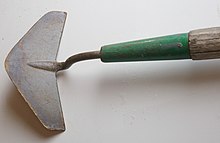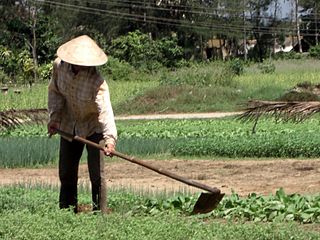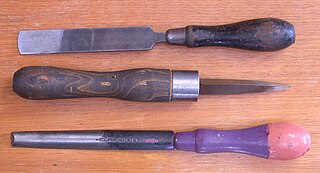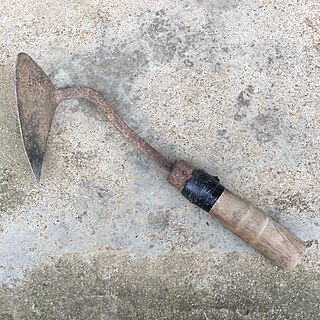
A number of common weeding tools are designed to ease the task of removing weeds from gardens and lawns.

A number of common weeding tools are designed to ease the task of removing weeds from gardens and lawns.
No-dig gardening is a non-cultivation method used by some organic gardeners.

A blade is the sharp, cutting portion of a tool, weapon, or machine, specifically designed to puncture, chop, slice, or scrape surfaces or materials. Blades are typically made from materials that are harder than those they are intended to cut. This includes early examples made from flaked stones like flint or obsidian, evolving through the ages into metal forms like copper, bronze, and iron, and culminating in modern versions made from steel or ceramics. Serving as one of humanity's oldest tools, blades continue to have wide-ranging applications, including in combat, cooking, and various other everyday and specialized tasks.

A spade is a tool primarily for digging consisting of a long handle and blade, typically with the blade narrower and flatter than the common shovel. Early spades were made of riven wood or of animal bones. After the art of metalworking was developed, spades were made with sharper tips of metal. Before the introduction of metal spades manual labor was less efficient at moving earth, with picks being required to break up the soil in addition to a spade for moving the dirt. With a metal tip, a spade can both break and move the earth in most situations, increasing efficiency. A classic spade, with a narrow body and flat tip is suited for digging post holes, and is not to be confused with a "roundpoint" shovel, which has a wider body and tapered tip.

A hoe is an ancient and versatile agricultural and horticultural hand tool used to shape soil, remove weeds, clear soil, and harvest root crops. Shaping the soil includes piling soil around the base of plants (hilling), digging narrow furrows (drills) and shallow trenches for planting seeds or bulbs. Weeding with a hoe includes agitating the surface of the soil or cutting foliage from roots, and clearing the soil of old roots and crop residues. Hoes for digging and moving soil are used to harvest root crops such as potatoes.

A loader is a heavy equipment machine used in construction to move or load materials such as soil, rock, sand, demolition debris, etc. into or onto another type of machinery.

Pliers are a hand tool used to hold objects firmly, possibly developed from tongs used to handle hot metal in Bronze Age Europe. They are also useful for bending and physically compressing a wide range of materials. Generally, pliers consist of a pair of metal first-class levers joined at a fulcrum positioned closer to one end of the levers, creating short jaws on one side of the fulcrum, and longer handles on the other side. This arrangement creates a mechanical advantage, allowing the force of the grip strength to be amplified and focused on an object with precision. The jaws can also be used to manipulate objects too small or unwieldy to be manipulated with the fingers.

A string trimmer, also known by the portmanteau strimmer and the trademarks Weedwacker, Weed Eater and Whipper Snipper, is a garden tool for cutting grass, small weeds, and groundcover. It uses a whirling monofilament line instead of a blade, which protrudes from a rotating spindle at the end of a long shaft topped by a gasoline engine or electric motor.

A trowel is a small hand tool used for digging, applying, smoothing, or moving small amounts of viscous or particulate material. Common varieties include the masonry trowel, garden trowel, and float trowel.

A digging stick, sometimes called a yam stick, is a wooden implement used primarily by subsistence-based cultures to dig out underground food such as roots and tubers, tilling the soil, or burrowing animals and anthills. It is a term used in archaeology and anthropology to describe similar implements, which usually consists of little more than a sturdy stick which has been shaped or sharpened and sometimes hardened by being placed temporarily in a fire.

A garden fork, spading fork, or digging fork is a gardening implement, with a handle and a square-shouldered head featuring several short, sturdy tines. It is used for loosening, lifting and turning over soil in gardening and farming, and not to be confused with the pitchfork, a similar tined tool used for moving loose materials such as hay, straw, silage, and manure.

A rake is a broom for outside use; a horticultural implement consisting of a toothed bar fixed transversely to a handle, or tines fixed to a handle, and used to collect leaves, hay, grass, etc., and in gardening, for loosening the soil, light weeding and levelling, removing dead grass from lawns, and generally for purposes performed in agriculture by the harrow.

A bottle opener is a device that enables the removal of metal bottle caps from glass bottles. More generally, it might be thought to include corkscrews used to remove cork or plastic stoppers from wine bottles.

A framing hammer is a form of claw hammer used for heavy wood construction, particularly house framing and concrete formwork. It is a heavy duty rip hammer with a straight claw and a wood, metal, or fiberglass handle. Head weights vary from 20 to 32 ounces for steel, and 12 to 16 ounces for titanium. Heavy heads, longer handles and milled faces allow for driving large nails quickly into dimensional lumber. Other features include a sharp checkerboard "milled" face for gripping nails, and, since the 1980s, an unusually large and short face for increasing driving area without increasing weight.

A hand scraper is a single-edged tool used to scrape metal or other materials from a surface. This may be required where a surface needs to be trued, corrected for fit to a mating part, needs to retain oil, or to give a decorative finish.

The foot plough is a type of plough used like a spade with the foot in order to cultivate the ground.

A fire iron is any metal instrument for tending a fire.

A kitchen scraper is a kitchen implement made of metal, plastics, wood, rubber or silicone rubber. In practice, one type of scraper is often interchanged with another or with a spatula for some of the various uses.
A cane knife is a large hand-wielded cutting tool similar to a machete. Its use is prevalent in the harvesting of sugarcane in dominant cane-growing countries such as Peru, Brazil, Colombia, Australia, South Africa, Ecuador, Cuba, Jamaica, the Philippines and parts of the United States, especially Louisiana and Florida, as well as Hawaii. It is the primary tool used in countries that do not employ mechanical means for harvesting cane.

A cheese knife is a type of kitchen knife specialized for the cutting of cheese. Different cheeses require different knives, according primarily to hardness. There are also a number of other kitchen tools designed for cutting or slicing cheese, especially the harder types. These include the cheese cutter, cheese slicer, cheese plane, cheese scoop for soft cheese and others, collectively known as cheese servers.

Homi, also known as a Korean hand plow, is a short-handled traditional farming tool used by Koreans. It is a farming tool that removes grasses from paddies and fields. It is also used when plowing a rice field, planting seeds, plowing up soil, and digging potatoes in fields. It is a farming tool similar to the hoe. It is an important extension of agriculture from the ancient times because the homi was excavated in the Bronze Age historic site of the Pyeongnam Mangsan Daepyeong-ri and the early Iron Age historic site of Yangpyong, Gyeonggi Province.